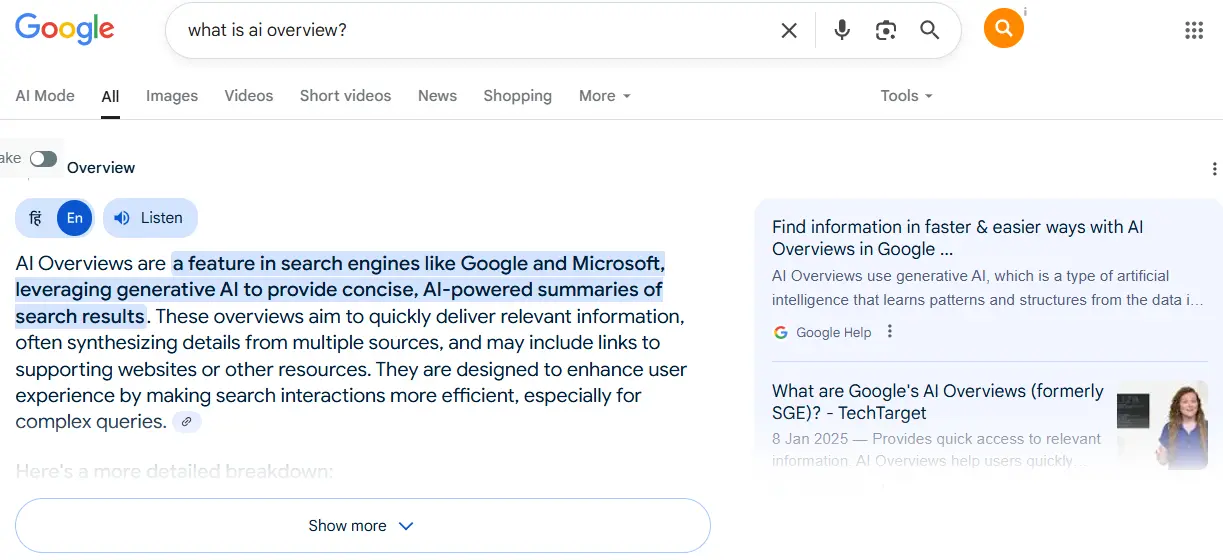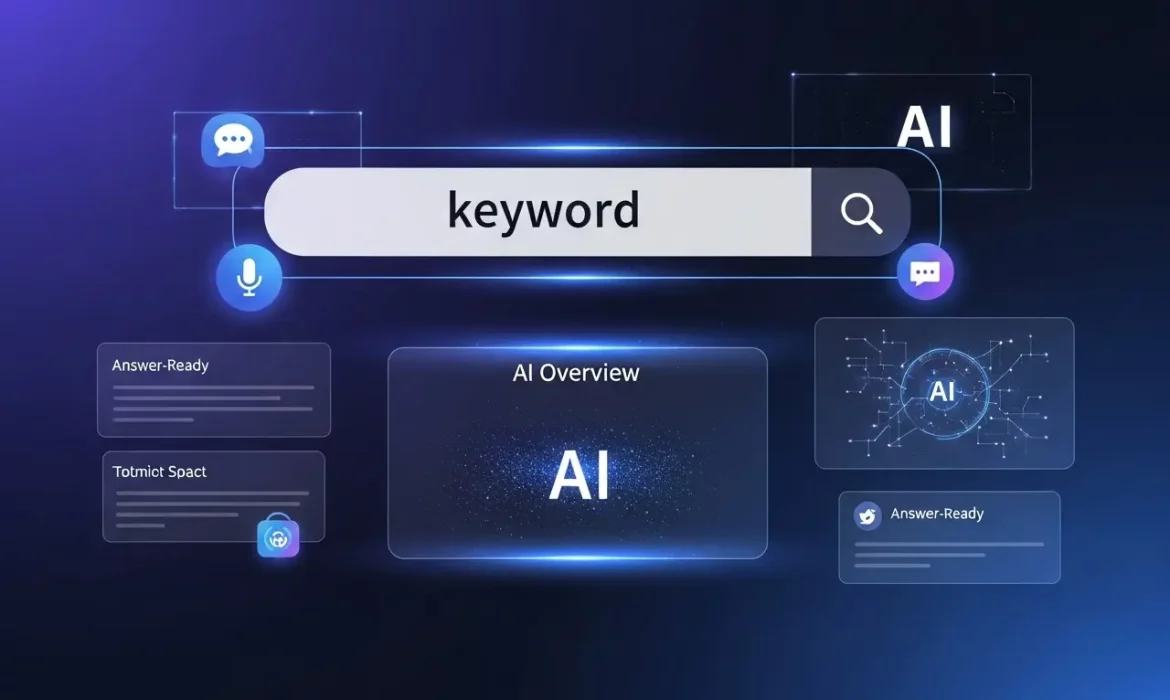With AI’s increasing dominance in search engine results, the conventional search engine results page (SERP) is evolving rapidly. Google’s AI-driven Overviews and the Search Generative Experience (SGE) are changing how content is displayed.
Instead of simply listing links, Google now provides immediate, summarized answers directly on the SERP. This shift is leading to zero-click searches, where users get the answers they need without clicking on any websites.
To thrive in this new landscape, businesses need to optimize their content for these AI-powered features. But how do you do that? How can your content rise above the noise and be featured in these high-visibility AI overviews?
The key is to create answer-ready content that not only satisfies user intent but is also easily interpreted by AI models. Let’s explore how businesses can adapt to AI Overviews and ensure their content ranks in these next-gen search results.
Why Ranking in AI Overviews is Crucial for Your Business?

AI Overviews, which show up at the top of search results, are brief, AI-generated answers to user inquiries. These summaries aim to provide direct answers, often without the user having to click on any link.
Powered by advanced machine learning algorithms, AI Overviews focus on delivering high-quality, relevant information pulled from multiple sources to create a comprehensive response.
In essence, AI is transforming the traditional search engine model, providing a more conversational, context-aware search experience for users. As a result, businesses must focus on ranking in these AI-driven sections to ensure their content is noticed.
The Shift in User Behaviour
According to a study, over 60% of Google searches in 2024 ended without a click, a trend fuelled by AI features like Overviews and AI mode. This has profound implications for content marketing.
While traditional SEO strategies like link building and keyword targeting still matter, AI Overviews are quickly becoming a dominant feature in search results. If you’re not optimizing for AI Overviews, you may be missing out on massive visibility opportunities.
By 2025, the percentage of zero-click searches is expected to exceed 70%, underscoring the need to adapt your strategy to stay competitive.
How AI Overviews Work and What They Favour?
AI-driven search responses differ significantly from traditional search results. While traditional search results provide a list of links, AI Overviews generate detailed, readable answers to specific queries.
These answers may come in the form of bullet points, short paragraphs, or even carousel answers.
Here’s what makes AI Overviews distinct:
- Multi-stage Processing: AI breaks down complex queries into subtopics, ensuring that all aspects of the query are answered.
- Source Integration: Although AI produces a synthesized response, it still links to the original sources for transparency and fact-checking.
- Real-time Data Synthesis: AI models pull from updated, credible sources to ensure the answers reflect current data.
Content Structure for AI
To bring your content featured in AI Overviews, you need to optimize its structure:
- Clear Headings: Use H2 and H3 tags for question-based headings to guide AI models.
- Concise Answers: Provide short, clear answers in the first 50–100 words. AI Overviews prioritize content that directly answers the query without unnecessary fluff.
- Structured Data: Implement schema markup (FAQ, HowTo, etc.) to help AI models understand your content’s context and enhance the chances of being included in AI Overviews.
- Multimedia Integration: Incorporate images, videos, and infographics to make your content more engaging for both AI models and users
Key Strategies to Rank in AI Overviews
Ranking in AI overviews requires more than just traditional SEO tactics. To stand out, your content needs to be structured for AI algorithms, optimized for user intent, and continuously updated. Let’s explore proven strategies:
1. Create Answer-Oriented Content
The primary goal of AI Overviews is to answer questions directly. This means that your content needs to address user queries clearly. Focus on creating detailed Q&A sections, step-by-step guides, and how-to content that immediately provides value.
- Target User Intent: Understand the intent behind user queries. Are they looking for an answer, a guide, or a comparison?
- Direct Answers: Start your content with a direct response to the question, followed by more detailed information in the body.
2. Optimize with Structured Data
Structured data is essential for AI Overviews. Schema markup helps AI understand the context of your content and present it accurately in SERPs.
- FAQ Schema: Use this to structure common questions and their answers.
- HowTo Schema: If your content involves a process, use this schema to break down the steps.
- Article Schema: Helps AI categorize and display relevant articles in Overviews.
3. Use Plain, Accessible Language
AI models, such as Google’s Gemini, prioritize clear, simple language. Avoid jargon and overly complex sentences. Write in an easily digestible style so that your content is not only useful to humans but also easy for AI to process.
4. Integrate Multimedia
AI models also pull data from images, videos, and other multimedia sources to enhance the content. By incorporating high-quality media like images, charts, and videos, you can increase your chances of being featured.
- Use Alt Text: Ensure that all media is properly tagged with descriptive, relevant keywords.
- Optimize Videos: Adding captions, transcripts, and timestamps can help AI models index video content more efficiently.
5. Focus on Long-Tail Keywords
Long-tail keywords are essential for ranking in AI Overviews. These queries are often highly specific and are more likely to trigger direct, AI-generated answers.
- Example: Instead of targeting a broad keyword like “SEO tips,” focus on something more specific like “how to plan and optimize your blog post for SEO in 2025.”
- Use Tools: Leverage tools like Google’s People Also Ask and AnswerThePublic to uncover long-tail questions that your audience is asking.
How AI is Impacting Content Marketing in Social Media (Organic & Paid Ads)
AI is transforming content marketing across platforms like Instagram, YouTube, and Facebook. With AI-driven algorithms enhancing targeting, personalization, and ad optimization, businesses are leveraging AI to ensure their content resonates deeply with their audience.
- AI in Organic Posts: Instead of targeting a broad keyword like “SEO tips,” focus on something more specific like “how to plan and optimize your blog post for SEO in 2025.”
- AI in Paid Ads: AI-driven ad platforms, like Facebook’s AI, optimize targeting, ad creatives, and budgets in real-time, ensuring better performance and ROI.
AI’s Impact on Reels and Shorts
AI has brought a significant shift to how short-form videos (Reels, Shorts) perform. These platforms now benefit from enhanced AI algorithms that help businesses connect with their audience through targeted, engaging videos.
- AI-Optimized Video Content: AI tools now help creators identify the type of content that works best for their audience.
- Structured Data for Videos: Just like written content, video content now benefits from structured data, enabling AI to index and recommend it more effectively.
Building Trust and Authority with AI
AI Overviews prioritize E-E-A-T, which means content needs to reflect expertise and authority. By consistently producing authoritative, well-researched, and fact-based content, businesses can build trust with both AI models and users.
- Cite Authoritative Sources: Link to authoritative websites and research to back up your claims.
- Showcase Expertise: Use expert-written content and include author bios to showcase credibility.
Regular Content Updates
AI Overviews include current and new content. To stay visible, update your articles frequently to reflect the most recent facts, trends, and best practices.
- Set a Content Calendar: Regular updates signal to AI that your content is current and relevant.
AI Overview Performance Monitoring & Analytics
Monitoring the performance of your content in AI Overviews is essential. AI Overviews are brief answers to user questions that are produced by AI and show up at the top of search results.
- Check Featured Snippets: Monitor whether your content is appearing in AI Overviews or if it’s underperforming.
- Optimize Based on Data: Make data-driven decisions to optimize underperforming content.
Adjust and Optimize
Refine your content based on click-through rates and bounce rates. Regularly update your content to reflect user interests, search intent shifts, and AI model improvements.
EvenDigit Helps Future-Proof Your Content for AI-Driven Search Results
At EvenDigit, we ensure your content is optimized for both human readers and AI algorithms. Our expert content writers and SEO experts collaborate from scratch to craft authoritative, high-quality content that ranks well in organic search and aligns with your business goals.
By understanding your audience’s search intent, we create content that answers their questions directly. We implement structured data and optimize on-page SEO to ensure that AI systems can easily digest and rank your content.
Our team also ensures your content remains relevant through ongoing updates, keeping you ahead of AI-driven search trends.
With EvenDigit, you’re not just preparing for AI-driven search results; you’re dominating them, making your brand an authority in your industry.
EvenDigit
EvenDigit is an award-winning Digital Marketing agency, a brand owned by Softude (formerly Systematix Infotech) – A CMMI Level 5 Company. Softude creates leading-edge digital transformation solutions to help domain-leading businesses and innovative startups deliver to excel.
We are a team of 70+ enthusiastic millennials who are experienced, result-driven, and hard-wired digital marketers, and that collectively makes us EvenDigit. Read More




